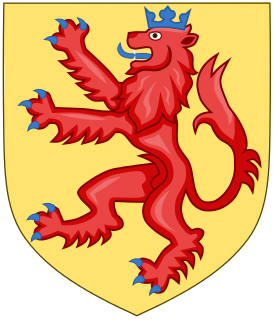
The House of Habsburg, also House of Austria, was one of the most prominent royal houses of Europe in the 2nd millennium.

Philip II was King of Spain (1556–1598), King of Portugal, King of Naples and Sicily, and jure uxoris King of England and Ireland. He was also Duke of Milan from 1540. From 1555 he was Lord of the Seventeen Provinces of the Netherlands.

Albert VII was the ruling Archduke of Austria for a few months in 1619 and, jointly with his wife, Isabella Clara Eugenia, sovereign of the Habsburg Netherlands between 1598 and 1621. Prior to this, he had been a cardinal, archbishop of Toledo, viceroy of Portugal and Governor General of the Habsburg Netherlands. He succeeded his brother Matthias as reigning archduke of Lower and Upper Austria, but abdicated in favor of Ferdinand II the same year, making it the shortest reign in Austrian history.

The Treaty of London, signed on 18 August O.S. 1604, concluded the nineteen-year Anglo-Spanish War. The treaty restored the 'Status quo' between the two nations. The negotiations probably took place at Somerset House in Westminster and are sometimes known as the Somerset House Conference.

Isabella Clara Eugenia, sometimes referred to as Clara Isabella Eugenia, was sovereign of the Spanish Netherlands in the Low Countries and the north of modern France with her husband, Archduke Albert VII of Austria. Their reign is considered the Golden Age of the Spanish Netherlands. Isabella was one of the most powerful women in 16th- and 17th-century Europe.

The Distinguished Order of the Golden Fleece is a Catholic order of chivalry founded in Bruges by Philip the Good, Duke of Burgundy, in 1430, to celebrate his marriage to Isabella of Portugal. Today, two branches of the order exist, namely the Spanish and the Austrian Fleece; the current grand masters are Felipe VI, King of Spain and Karl von Habsburg, head of the House of Habsburg-Lorraine, respectively. The Grand Chaplain of the Austrian branch is Cardinal Christoph Schönborn, Archbishop of Vienna.
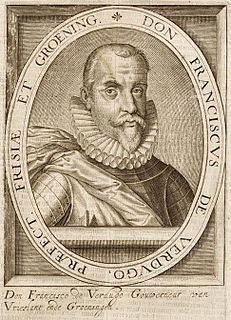
Francisco Verdugo, Spanish military commander in the Dutch Revolt, born in 1537 in, became Maestre de Campo General, in the Spanish Netherlands. He was also the last Spanish Stadtholder of Friesland, Groningen, Drenthe and Overijssel between 1581 and 1594.

Princely Count Charles of Arenberg, duke of Aarschot, baron of Zevenbergen, knight of the Order of the Golden Fleece, was the second Princely Count of Arenberg and a leading aristocrat of the Habsburg Netherlands, who served as a courtier, soldier, minister and diplomat.
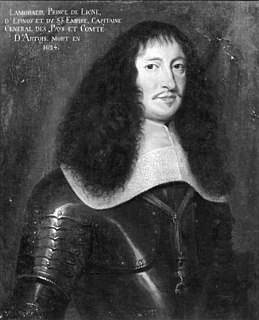
Lamoral, 1st Prince of Ligne was a diplomat in the 17th century.

Jean Grusset dict Richardot, knight was a statesman and diplomat from the Franche-Comté, who held high political office during the Dutch Revolt and played an important role in restoring Habsburg rule in the Southern Netherlands.

The Siege of Amiens was a siege and battle fought during the Franco-Spanish War (1595-1598) and the Anglo-Spanish War (1585–1604) between 13 May and 25 September 1597. The Spanish, who had sent a large army in March, had captured the city of Amiens easily in a ruse. Henry IV of France, after the surprise of the capture, immediately and quickly built up an army which included a large English force and besieged Amiens on 13 May.

The siege of Calais of 1596, also known as the Spanish conquest of Calais, took place at the strategic port-city of Calais, between April 8–24, 1596, as part of the Franco-Spanish War (1595–1598), in the context of the French Wars of Religion, the Anglo-Spanish War (1585–1604), and the Eighty Years' War. The siege ended when the city fell into Spanish hands after a short and intense siege by the Spanish Army of Flanders commanded by Archduke Albert of Austria, Governor-General of the Spanish Netherlands. The French troops in the citadel of Calais resisted for a few days more, but finally on April 24, the Spanish troops led by Don Luis de Velasco y Velasco, Count of Salazar, assaulted and captured the fortress, achieving a complete victory. The Spanish success was the first action of the campaign of Archduke Albert of 1596.
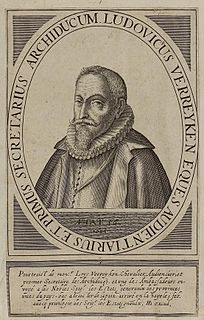
Louis Verreycken, Lord of Impden, Sart, Ruart, Hamme was secretary of the Brussels Council of State and audiencier of the Brussels Privy Council.

Philip Numan was a Flemish lawyer and humanist, a writer in prose and verse, sometimes under the pen name Hippophilus Neander.
Events from the 1590s in the Spanish Netherlands and Prince-bishopric of Liège.

Albert de Ligne (1600–1674), Prince of Barbançon and Arenberg, knight of the Golden Fleece, was a Netherlandish nobleman and military commander in the Thirty Years' War and the Eighty Years' War.
Jacques Blaseus (c.1540–1618) was successively bishop of Namur and bishop of Saint-Omer in the Spanish Netherlands.
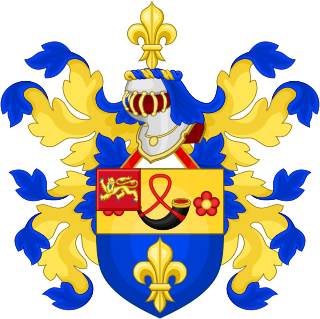
The Rubens family is a Flemish noble family that lived in Antwerp.
Gilles du Faing, lord of Linay and Griffemont, baron of Jamoigne, was a soldier and diplomat in the service of Philip II of Spain and the Archdukes Albert and Isabella.

Francisco López de Mendoza y Mendoza, in the literature often simply referred to as Francisco de Mendoza, was a Spanish nobleman, diplomat, general, and eventually bishop, who briefly played an important role in the Eighty Years' War.

















